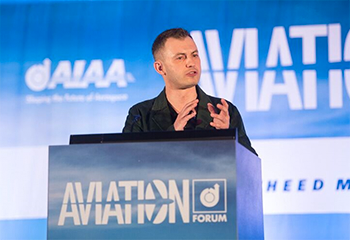Third Aerospace Revolution Rapidly Changing the Face of Aviation Written 6 June 2017
Speaker: Paul Eremenko, chief technology officer, Airbus
by Lawrence Garrett, AIAA Web Editor

Airbus is determined to play a leading role in what Paul Eremenko, Airbus’ chief technology officer, considers the third aerospace revolution.
“This is a chance not just to influence, not just to leave a mark, but really to imagine and build the future of flight together,” Eremenko said June 6 during his keynote address, titled “Innovation in the Age of the Third Aerospace Revolution,” at the 2017 AIAA AVIATION Forum in Denver.
Referencing the Wright brothers and the dawn of aviation as the first revolution and the jet age of the 1950s as the second, Eremenko said that the third revolution, as evidenced by the current confluence of developing technologies and business opportunities, is remarkable.
“I could never have imagined in my wildest dreams that ... a multibillion dollar market for commercial and consumer drones would emerge — and not just from us, the disruptors at the time, but from the cellphone industry,” he said. “When you have this kind of rapid technological evolution across multiple different domains, some kind of convergence, something interesting, is almost bound to happen.”
Eremenko explained that digital and electrical technological developments have already created a revolution in the aerospace industry that will lead to an even bigger development.
“I’m talking about the ability to manipulate matter, or in other words, the ability to design and create new materials and structures with ease and flexibility of writing a software specification,” he said, referring to reconfigurable manufacturing robotics, direct metal 3-D printing, and the ability to create new materials and structures using biological synthesis. “These and other technologies give us mastery over the creation of the physical product, could well lower the barrier to entry to aerospace even further and lead to opportunities for disruption.”
Referring to a presentation given by Airbus CEO Tom Enders at AIAA AVIATION 2015 in which Enders asked, “Are we moving fast enough,” Eremenko echoed Enders: “When we launched Airbus back in 1969, we weren’t just bold. Some might say we were downright rude. And it worked.”
Eremenko also discussed the rapid advances in electric flight. In 2010, Airbus sponsored the development of a small all-electric aircraft that has seen advancements every year since. In 2015, an Airbus test pilot flew the E-Fan across the English Channel.
Eremenko said the first powered flight of Airbus’ Vahana, a single-passenger all-electric, fully autonomous vertical takeoff and landing air-taxi demonstrator with a tilt-wing configuration, is slated for later this year.
“In V/TOL, we stand at a convergence point of several new technologies, namely autonomy, electric propulsion, low-cost mass manufactured composites ... and the digitally enabled business model of on-demand personal mobility,” Eremenko said. “Combined, they seem to offer the realistic prospect of a new class of vehicles that could make the dream of urban air mobility finally real.”
Eremenko cautioned that the industry is still in the early stages of the urban air mobility journey, but he said he would be “astonished” not to see in the next four to five years a full-scale pilot of an urban air transport system in a major city.
“And I sure as hell want to help build it,” he said.
